Gargano Peninsula, Italy - Europe's finest wild orchid site
List of orchid species seen during the trip...
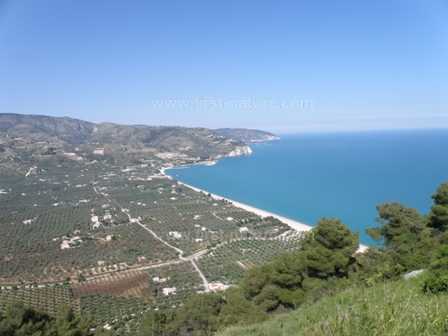
One of the beautiful beaches on the southern coast of the Gargano Peninsula
Despite extensive travels throughout Italy, which I love, in my twenties nothing prepared me for the strange site of the rolling limestone promontory of the Gargano Peninsula which loomed above the early summer evening mist as we drove towards it.
Just as, from a distance, The Burren in County Clare in Ireland, looks so utterly barren that nothing could possibly grow there; the Gargano Peninsula also looks as if it would be struggle to sustain life there. In fact, the geology is remarkably similar to that found in The Burren consisting largely of limestone pavement which provides little in the way of land that can easily be cultivated and farmed in order to sustain people. Intensive farming, the blight of so much of Europe's countryside and wildlife, cannot be practised in the Gargano Peninsula and the result is a stunning display of wildflowers and an abundance of birds, insects, reptiles and other wildlife that those of us who do not live there can only dream of.
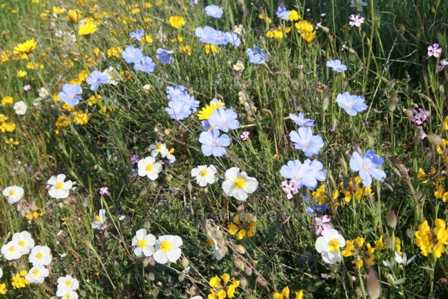
A typical flower-rich meadow in the Gargano National Park
The Gargano Peninsula is part of the 'spur' on the so-called 'boot' of southern Italy. We flew into Bari Airport and continued by road from there. The drive to reach Monte Sant'Angelo on the northern coast is approximately one and a half hours from the airport, but if you want to start your trip on the southern coast it will take at least an hour longer.
Once an island, the Gargano Peninsula was covered by the ancient forest of oak and beech that is supposed to have covered much of Central Europe. Today it is a well-known tourist destination where visitors flock to the lovely beaches and seaside resorts on its southern coast. It is also a place of great religious significance and is home to the oldest shrine in Western Europe dedicated to St. Michael, Monte Sant'Angelo sul Gargano. For those interested in wildlife, and wildflowers in particular, it is the area designated as a National Park in 1991 that will hold the most interest.
Below: The wild orchids are not hard to find!
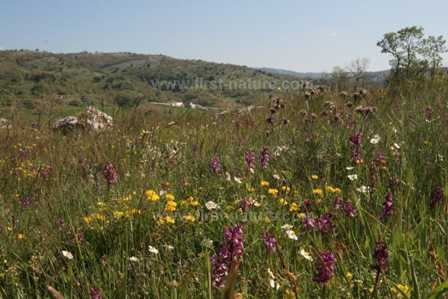
Parco Nazionale del Gargano covers an area of approximately 120,000 hectares of immensely varied habitats from rocky coastlines and wetlands to flower-filled meadows and forests. Over 2,000 species of plants inhabit Gargano and this includes the highest concentration of wild orchid species in Europe including many strange and wonderful hybrids.
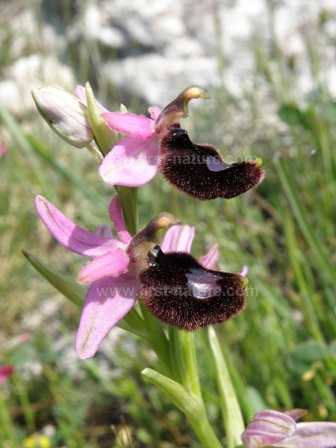
Ophrys bertolonii flowers freely on a Gargano hillside close to Monte Sant'Angelo.
One of the fascinations of Gargano's wild orchids is the amazing variations in the orchids present there - particularly amongst the Ophrys species.
In many places finding wild orchids can be a hit and miss affair at best and a complete wild-goose chase at worst, and nearly everyone with an interest in these wonderful plants will have arrived full of hope in places where plants of particular interest are said to occur, only to leave in despair many hours later having scoured every millimetre of the site with zero success. There is none of that to worry about in Gargano. If you are there at the right time, the orchids will be there in numbers that you simply cannot comprehend - or miss.
The most talked-about of them all are the bee orchids Ophrys species. Not only are there a lot of them, but it is also the hybrids between species that stimulates so much interest and debate. However, there were some unforgettable alternatives to enjoy: Giant Orchids Himantoglossum robertianum growing next to massive Lady Orchids Orchis purpurea, surrounded by drifts of Orchis quadripunctata was one. Another was the sight of four different species growing together in one tiny rock crevice: Man Orchid Orchis anthropophora, Sparse-flowered Orchid Orchis pauciflora, Four-spotted Orchid Orchis quadripunctata and Yellow Bee Orchid Ophrys lutea. Sights such as these were commonplace, and after a while, almost overwhelming if you were trying to keep tally of what you had seen each day.
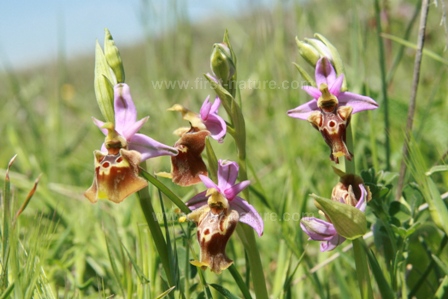
But, be warned - if you are a person who likes certainty in identification, and to 'tick boxes' of species found, the wild orchids of the Gargano will drive you to distraction. So, be philosophical: enjoy the flowers and the sunshine and revel in the outstanding diversity of nature! Leave the puzzlement to those who feel compelled to try and work out what is going on with the orchids - are they species, sub-species, varieties, forms, hybrids or all of one species as diverse as we are perhaps?
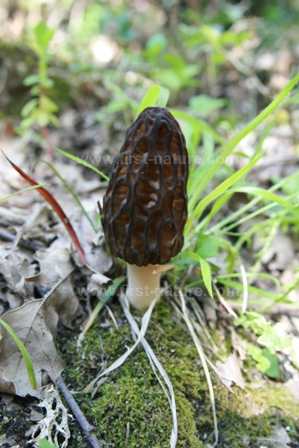
A wonderful bonus of an early visit to Foresta Umbra is the chance of finding Morels.
Another word of caution: maybe fewer identification guides are better than many. We travelled with a fairly recent copy of Delforge and acquired two further books during our stay there. There was a direct correlation between our level of confusion and the number of pictures and opinions we consulted in our search for The Truth.
An ideal time to visit Gargano to see the wealth of wildflowers would be mid-to-late April, and the visit would be best spent in two destinations, one in the north and the other in the south. Whilst many of the plants can be seen within walking distance of hotels it would be a good idea to have a hire car so that excursions can be made into the forested areas and the less-populated parts.
Good places to visit in order to see more of the wildflowers and wild orchids of the area are Monte Sacro in the north and and Bosco di Spinapulci in the south. At the summit of Monte Sacro there are the ruins of the old abbey of St. Maria, but on your way up there are wonderful flowers to be seen along the route including the lovely yellow Orchis pauciflora. The rocky hillside at Bosco di Spinapulci in the south is covered with Serapias cordigera - Heart-flowered Tongue Orchid - as well as Orchis fragrans - the Fragrant Bug Orchid.
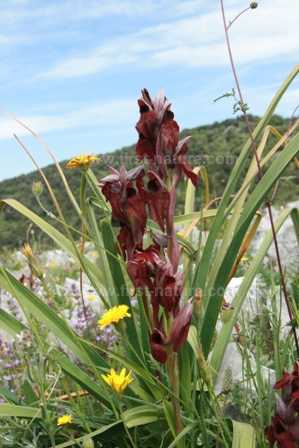
A lovely group of Serapias cordigera at Bosco di Spinapulci in the southern part of the Gargano Peninsula
A number of tongue orchids grow in this part of Italy, and the two local guide books disagree about the species and list several subspecies. I felt confident that we had found Serapias lingua, Serapias apulica (a subspecies of Serapias orientalis), Serapias cordigera, Serapias vomeracea and the Small-flowered Tongue orchid, Serapias parviflora.
Orchid Species in Gargano
Top of page...